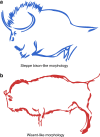Early cave art and ancient DNA record the origin of European bison
- PMID: 27754477
- PMCID: PMC5071849
- DOI: 10.1038/ncomms13158
Early cave art and ancient DNA record the origin of European bison
Abstract
The two living species of bison (European and American) are among the few terrestrial megafauna to have survived the late Pleistocene extinctions. Despite the extensive bovid fossil record in Eurasia, the evolutionary history of the European bison (or wisent, Bison bonasus) before the Holocene (<11.7 thousand years ago (kya)) remains a mystery. We use complete ancient mitochondrial genomes and genome-wide nuclear DNA surveys to reveal that the wisent is the product of hybridization between the extinct steppe bison (Bison priscus) and ancestors of modern cattle (aurochs, Bos primigenius) before 120 kya, and contains up to 10% aurochs genomic ancestry. Although undetected within the fossil record, ancestors of the wisent have alternated ecological dominance with steppe bison in association with major environmental shifts since at least 55 kya. Early cave artists recorded distinct morphological forms consistent with these replacement events, around the Last Glacial Maximum (LGM, ∼21-18 kya).
Figures




Comment in
-
The Year of the Wisent.BMC Biol. 2016 Nov 18;14(1):100. doi: 10.1186/s12915-016-0329-3. BMC Biol. 2016. PMID: 27863491 Free PMC article.
References
-
- Kurtén B. Pleistocene Mammals of Europe (1968).
-
- Geist V. The relation of social evolution and dispersal in ungulates during the Pleistocene, with emphasis on the old world deer and the genus Bison. Quat. Res. 1, 285–315 (1971).
-
- Benecke N. The holocene distribution of European bison: the archaeozoological record. Munibe Antropol. Arkeol. 57, 421–428 (2005).
-
- Stuart A. J. Mammalian extinctions in the late Pleistocene of Northern Eurasia and North America. Biol. Rev. 66, 453–562 (1991). - PubMed
Publication types
MeSH terms
Substances
LinkOut - more resources
Full Text Sources
Other Literature Sources

